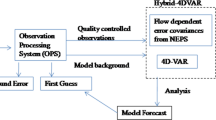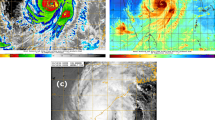Abstract
This study aims to present an encouraging example of prediction of super cyclone Gonu over the northern Indian Ocean in 2007. A series of experiments are conducted using the advanced Weather Research and Forecasting model with three-dimensional variational method to assimilate GPS RO refractivity from FORMOSAT-3/COSMIC (hereafter referred as GPS) and radiosonde sounding (GTS) to highlight the relative impact of GPS RO data on model prediction. Significant differences in cyclone track and intensity prediction are exhibited in various experiments with and without cyclic assimilations. Both cold-start (non-cyclic) and hot-start (cyclic) runs with GPS RO data exhibit improvement on later track prediction compared to the control run without data assimilation. GPS experiment outperforms other experiments including GTS in track prediction with the smallest cross-track error. Sensitivity tests were also conducted to identify which GPS RO sounding gives more impact on track prediction. We found that the sounding closest to the cyclone exhibits the largest contribution to track prediction. Assimilation of the RO soundings in the vicinity of Gonu cyclone appears to modify the environmental conditions that result in a later development of a couplet of high and low pressure, leading to a positive impact on track prediction. Sensitivity experiments indicate that the initial information retrieved by GPS data at upper levels that produce colder temperature increments indeed contributes more improvement to track prediction.













Similar content being viewed by others
References
Anthes RA (2011) Exploring Earth’s atmosphere with radio occultation: contributions to weather, climate and space weather. Atmos Meas Tech 4:1077–1103
Anthes RA et al (2008) The COSMIC/FORMOSAT-3 mission: early results. Bull Am Meteorol Soc 89:313–333
Barker DM, Huang W, Guo Y-R, Bourgeois AJ, Xiao QN (2004) A three-dimensional variational data assimilation system for MM5: implementation and initial results. Mon Weather Rev 132:897–914
Chen S-Y, Huang C-Y, Kuo Y-H, Guo Y-R, Sokolovskiy S (2009) Assimilation of GPS refractivity from FORMOSAT-3/COSMIC using a nonlocal operator with WRF 3DVAR and its impact on the prediction of a typhoon event. Terr Atmos Oceanic Sci 20:133–154
Chen S-Y, Huang C-Y, Kuo Y-H, Sokolovskiy S (2011) Observational error estimation of GPS radio occultation refractivity and excess phase data. Mon Weather Rev 139:853–865
Cucurull L (2010) Improvement in the use of an operational constellation of GPS radio occultation receivers in weather forecasting. Weather Forecast 25:749–767
Cucurull L, Kuo Y-H, Barker D, Rizvi SRH (2006) Assessing the impact of simulated COSMIC GPS radio occultation data on weather analysis over the Antarctic: a case study. Mon Weather Rev 134:3283–3296
Healy SB (2008) Forecast impact experiment with a constellation of GPS radio occultation receivers. Atmos Sci Lett 9:111–118
Healy SB, Thepaut J-N (2006) Assimilation experiments with CHAMP GPS radio occultation measurements. Q J R Meteorol Soc 132:605–623
Healy SB, Jupp AM, Marquardt C (2005) Forecast impact experiment with GPS radio occultation measurements. Geophys Res Lett 32:L03804
Huang C-Y, Kuo Y-H, Chen S-H, Vandenberghe F (2005) Improvements on typhoon forecast with assimilated GPS occultation refractivity. Weather Forecast 20:931–953
Huang C-Y, Kuo Y-H, Chen S-Y, Rao ASKAVP, Wang C-J (2007) The assimilation of GPS radio occultation data and its impact on rainfall prediction along the west coast of India during monsoon 2002. Pure Appl Geophys 164:1577–1591
Huang C-Y, Kuo Y-H, Chen S-Y, Terng C-T, Chien F-C, Lin P-L, Kueh M-T, Chen S-H, Yang M-J, Wang C-J, Rao ASKAVP (2010) Impact of GPS radio occultation data assimilation on regional weather predictions. GPS Solut 14:35–49
Kliore AJ, Hamilton TW, Cain DL (1964) Determination of some physical properties of the atmosphere of Mars from changes in the Doppler signal of a spacecraft on an earth occultation trajectory. Jet Propulsion Laboratory, Technical Report, Pasadena, CA, pp 32–674
Krishnamurti TN, Bedi HS, Ingles K (1993) Physical initialization using SSM/I rain rates. Tellus 45A:247–269
Krishnamurti TN, Bhowmik SKR, Oosterhof D, Rohaly G (1995) Mesoscale signatures within the Tropics generated by physical initialization. Mon Weather Rev 123:2771–2790
Kueh M-T, Huang C-Y, Chen S-Y, Chen S-H, Wang C-J (2009) Impact of GPS radio occultation soundings on prediction of Typhoon Bilis 2006 landfalling Taiwan. Terr Atmos Ocean Sci 20:115–131
Kuo Y-H, Zou X, Huang W (1997) The impact of GPS data on the prediction of an extratropical cyclone: an observing system simulation experiment. J Dyn Atmos Ocean 27:413–439
Kuo Y-H, Sokolovskiy S, Anthes RA, Vandenberghe F (2000) Assimilation of GPS radio occultation data for numerical weather prediction. Terr Atmos Ocean Sci 11:157–186
Kuo Y-H, Wee T-K, Sokolovskiy S, Rocken C, Schreiner W, Hunt D, Anthes RA (2004) Inversion and error estimation of GPS radio occultation data. J Meteorol Soc Jpn 82:507–531
Kursinski E, Hajj G, Schofield J, Linfield R, Hardy K (1997) Observing earth’s atmosphere with radio occultation measurements using the Global Positioning System. J Geophys Res 102:23429–23465
Kursinski ER, Hajj GA, Leroy SS, Herman B (2000) The GPS radio occultation technique. Terr Atmos Ocean Sci 11:53–114
Liu H, Zou X (2003) Improvements to GPS radio occultation ray-tracing model and their impacts on assimilation of bending angle. J Geophys Res 108(D17):4548. doi:10.1029/2002JD003160
Liu H, Anderson J, Kuo Y-H, Snyder C, Caya A (2008) Evaluation of a nonlocal quasi-phase observation operator in assimilation of CHAMP radio occultation refractivity with WRF. Mon Weather Rev 136:242–256
Ma Z, Kuo Y-H, Wang B, Wu W-S, Sokolovskiy S (2009) Comparison of local and non-local observation operators for the assimilation of GPS radio occultation refractivity data in the NCEP GSI system: an observing system simulation experiment. Mon Weather Rev 137:3575–3587
Poli P, Moll P, Puech D, Rabier F, Healy SB (2008) Quality control, error analysis, and impact assessment of FORMOSAT-3/COSMIC in numerical weather prediction. Terr Atmos Ocean Sci 20:101–113
Poli P, Healy SB, Dee DP (2010) Assimilation of Global Positioning System radio occultation data in the ECMWF ERA–Interim reanalysis. J R Meteorol Soc 136:1972–1990
Potty J, Oo SM, Raju PVS, Mohanty UC (2012) Performance of nested WRF model in typhoon simulations over West pacific and South China Sea. Nat Hazard 63(3):1451–1470
Raju PVS, Potty J, Mohanty UC (2011) Sensitivity of physical parameterizations on prediction of tropical cyclone Nargis over the Bay of Bengal using WRF model. Meteorol Atmos Phys. doi:10.1007/s00703-011-0151-y
Sokolovskiy S, Kuo Y-H, Rocken C, Schreiner WS, Hunt D, Anthes RA (2003) Effect of superrefraction on inversions of radio occultation signals in the lower troposphere. Radio Sci 38:1058. doi:10.1029/2002RS002728
Sokolovskiy S, Kuo YH, Wang W (2005a) Assessing the accuracy of linearized observation operator for assimilation of the Abel-retrieved refractivity: case simulation with high-resolution weather model. Mon Weather Rev 133:2200–2212
Sokolovskiy S, Kuo YH, Wang W (2005b) Evaluation of a linear phase observation operator with CHAMP radio occultation data and high-resolution regional analysis. Mon Weather Rev 133:3053–3059
Zou X, Vandenberghe F, Wang B, Gorbunov ME, Kuo Y-H, Sokolovskiy S, Chang JC, Sela JG, Anthes R (1999) A raytracing operator and its adjoint for the use of GPS/MET refraction angle measurements. J Geophys Res 104:22301–22318
Zou X, Wang B, Liu H, Anthes RA, Matsumura T, Zhu YJ (2000) Use of GPS/MET refraction angles in 3D variational analysis. Q J R Meteorol Soc 126:3013–3040
Acknowledgments
This work is supported by National Science Council and National Space Organization in Taiwan.
Author information
Authors and Affiliations
Corresponding author
Rights and permissions
About this article
Cite this article
Anisetty, S.K.A.V.P., Huang, CY. & Chen, SY. Impact of FORMOSAT-3/COSMIC radio occultation data on the prediction of super cyclone Gonu (2007): a case study. Nat Hazards 70, 1209–1230 (2014). https://doi.org/10.1007/s11069-013-0870-0
Received:
Accepted:
Published:
Issue Date:
DOI: https://doi.org/10.1007/s11069-013-0870-0




